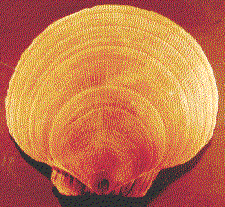| Bivalves are aquatic animals having
a worldwide distribution. They ranged from the Cambrian period, some
570 million years ago, to the present day. Cockles, scallops razor shells,
oysters, mussels and clams are all bivalves. Bivalves are the second largest
group of molluscs, and there are some 7,000 species of bivalve living today.
Other molluscs include gastropods and the cephalopods - ammonites, belemnites,
nautiloids and goniatites. To learn more about cephalopods or gastropods,
click on the icons below. |
Cephalopods
|
 Gastropods Gastropods |
|
|
|
| Bivalves are often gregarious creatures
and sometimes their populations may be enormous, such as in the oyster
beds which occur on many sea floors. An example of enormous populations
in the fossil record is the bivalve Exogya cancellata from the rocks
of the Upper Cretaceous period of North America, whose population has been
traced without interruption from New Jersey to Mexico, a distance of 4,000
kilometers (2,500 miles). |
|
 |
 |
| Bivalves resemble brachiopods,
which also has a shell consisting of two halves, called valves. However, a closer view shows that each valve of a
bivalve is not symmetrical, whereas each valve of a brachiopod is symmetrical.
The two valves of a bivalve are usually mirror images of each other, whereas
the valves of a brachiopod differ in size. There are exceptions to this,
such as Gryphaea from the Triassic and Jurassic periods where one valve
is much larger than the other. Unlike the brachiopods, which are
usually found as complete fossils with both valves, bivalves tend to open
their shells after death and so their fossils are more commonly found as
isolated single valves. To learn about brachiopods, click on the
icon below |
|

Brachiopods |
|
| The first bivalves which appeared
in the early Ordovician period were marine, and they begin to become reasonably
common fossils in the rocks of the Silurian and Devonian periods.
The shells of bivalves in rocks older than those of the Carboniferous period
are not generally preserved, these fossils largely consist of impressions
in the rock. Freshwater species first appear at the boundary between the
Silurian and Devonian periods. All of the major groups of bivalves were
in existence by the end of the Paleozoic era. |
|
| Bivalves are much more numerous and
varied in rocks from the Mesozoic era, and they may occur in great numbers
at some localities. Many of the ancient bivalve forms became extinct during
the Triassic period and were replaced by many new forms, some of which
have existed to this present day.
Bivalves, like the gastropods, are very abundant fossils in rocks
of the Cenozoic era. Many of these bivalves are related to living forms
so it is possible to state with some confidence the conditions under which
the rocks they are found in were deposited, such as shallow marine water,
brackish or freshwater, and under sub-tropical or a cold climate, etc.
To see example of what we have found click on an icon below. |
|
|
|

Bivalves |
|


